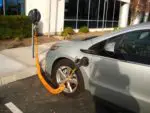Electric cars are the latest revolution. While hybrid cars have been available to the average consumer for a while, now fully electric cars are becoming available in prices even the average individual can afford. Popular brands include BMW i3, Ford Focus Electric, Mitsubishi i-MiEV, Nissan LEAF, Tesla Model S, Tesla Model X, Kia Soul, Chevrolet Spark EV—all of which are available in Canada—and popular car companies like Honda are switching gears to put their main focus on electric vehicles. Electric and plug-in hybrid vehicles are a growing trend with high demand across the US and China, but how viable is it to own an electric car in Alberta?
Alberta’s electric potential
There are two ingredients necessary to the viability of electric cars taking off. First is affordability. As electric cars are coming closer and closer to meeting the prices of non-electric cars, the viability of more of the population owning an electric car is becoming more and more achievable. However, that’s just one half of the equation. The part that causes the most concern for individuals who are in the market for electric isn’t the affordability of the car, but the availability of charge stations. The US has experienced a significant surge in demand for electric cars, and with that increase in demand has come a significant increase in the availability of charge stations. But how does this compare in Canada, where demand isn’t quite as high, and where lulls in the population could mean charge stations are few and far between?
There are, however, a lot more charge stations around than you may have thought. In fact, there are thousands of public charge stations available across Canada for all makes of electric cars—you can visit Plugshare.com to view the charge stations that are available near you, as well as to map out your route when planning a trip.
Further, Tesla is doubling the number of charging ports it has available at a number of supercharger stations that are experiencing increased demand leading to charging congestion, and governments are likewise pushing to build more stations for drivers of other makes and models in high-demand areas. This push will help to mitigate the charge congestion that is currently causing a bit of a wait for some individuals during peak times.
How Much Does it Cost to Charge an Electric Car? The True Costs of Powering an EV
Is it enough of a push to make owning an electric car a viable option for everyone?
This is a valid concern—particularly for individuals living in rural and more remote regions, and particularly for those living in northern Alberta, where Plugshare.com reveals charge stations to be a lot fewer and more far-between. Right now, much of the increasing demand for electric cars is in Ontario, BC, and Quebec, in areas that have high populations and a lot less distance between urban centres and greater populated areas. For these individuals, the concern isn’t so high. The majority of charging (90%) happens overnight and at home. For the most part, electric cars can hold enough of a charge for day-to-day use—especially when day-to-day travel is relatively moderate. However, Canada still needs to work on creating a vaster network of public charging stations for the more remote regions that may not be experiencing the same increases in demand due to a lower population, but which would make owning an electric vehicle a much more viable option for those who need to commute longer distances though more remote regions on a more regular basis, as well as for those individuals who are living north of Edmonton in Alberta.
Ontario, for instance, is spending $20 million in grants with the goal of installing quick-charge stations every 60-80kms along major highways. It’s an initiative that needs to continue throughout the country in order for electric cars to become fully viable by the end of 2016.












